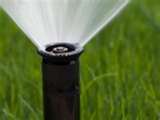IRRIGATION SYSTEM

One of the biggest culprits causing high water use may be your landscape irrigation system. Your system should be checked regularly for leaks, missing or clogged emitters on your drip lines, broken or missing sprinkler heads, cracked or broken pipes that are buried underground and leaky irrigation valves or ones that are stuck open. Check for wet or very green spots in your yard as this may indicate a leak. Make sure the spray patterns of the sprinkler heads and the water flow from the emitters are directing water appropriately. Check your irrigation controller to ensure that the settings have not changed or that the system is not malfunctioning. If you have a problem with gophers or other small critters, beware, they can chew through the irrigation water lines and create holes in the lines of your watering system. Tree roots can also grow around the irrigation lines causing them to crack and leak.
SWIMMING POOL
The most common problem with a pool can be the automatic fill valve. Often times this valve will become stuck and not shut off thereby constantly filling the pool. Occasionally there will be a crack in the pool surface that can go undetected. To test this, turn off the auto-fill, place a bucket with heavy rocks in it to anchor it and place the bucket on the top step of your pool. Fill the bucket with water so that the water level inside the bucket is the same as the level of water on the outside of the bucket. Do not cover the bucket. Check the bucket the next day. If the water level on the outside of the bucket is lower than the water inside the bucket, you probably have a crack in the surface of the pool and will need to call a pool company for repair. Also, do not overfill your pool. This will help minimize water loss due to splashing. Evaporative losses are normal. Use a pool cover to control evaporation and keep dirt and leaves out of your pool. This will reduce the need to backwash as often. When backwashing, only do so until the water runs clear. If you do need to have pool repairs made, find a reputable pool company that can do the repairs without draining your pool completely.
FOUNTAIN / WATER FEATURE
Fountains or water features can be a beautiful addition and good at masking the noise of traffic. Wildlife may also enjoy the benefits. Although not always a friend to water conservation, you can make your fountain more efficient by adjusting the float to avoid overflow, turning the fountain off on windy days, and installing a timer so that the water is running only when someone is home to appreciate it. When you perform a backwash on your fountain, make sure the excess water is directed to a turf area if possible. Check your fountain or water feature routinely for leaks.
EVAPORATIVE COOLER
An evaporative cooler (also know as a swamp cooler, desert cooler, and wet air cooler) is a device that cools air through the simple evaporation of water. Evaporative coolers require a constant supply of water to wet the pads. Proper maintenance is vital in order for maximum efficiency. Check the pan for corrosion that may result in a leak. Inspect the float assembly to make sure the water shuts off before reaching the overflow line. Lastly, use a recirculating pump and make necessary adjustments to ensure even water distribution on the pads.
NOTE: You can use this same method above to determine how much water is used when watering your landscape. Take a meter reading before and after use. The difference in the reading indicates how much water is being used during that cycle. You will need to do this for every station and every cycle.